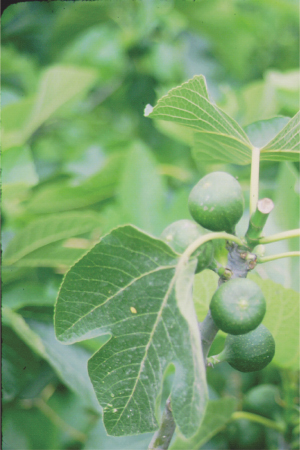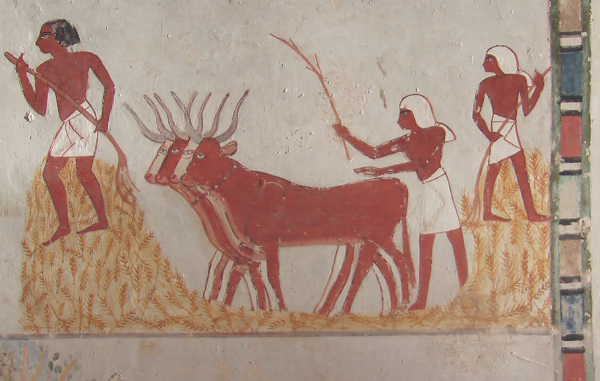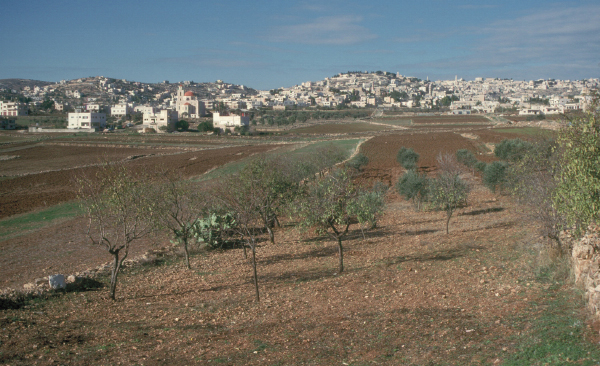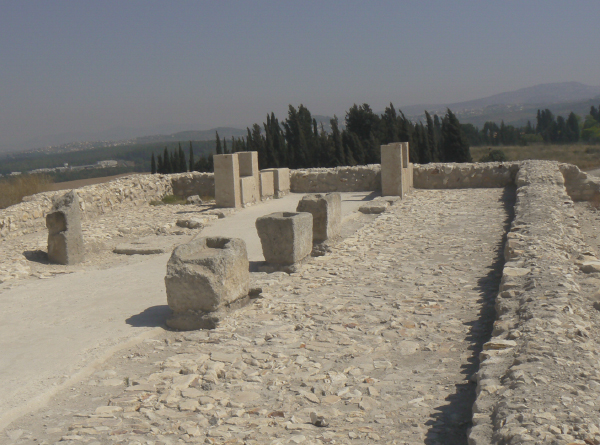A Picture of a Coming Day (4:1–5:15)
Mountain of the Lord (4:1–5). Like Isaiah, Micah presents both positive and negative pictures of the future, both occurring “in the last days” or “in that day.”55 In this vision, the abandoned “mountain” (3:12) is transformed into the center of the nations. Zion produces justice instead of bloodshed (3:9–11). War (1:10–16; 2:8–9) is overcome by images of peace. The lost inheritance (2:1–2) is restored.
But the placement of 4:1–5 immediately after chapter 3 results in a mixing of mountain metaphors. The mountain of the Lord was both a physical place, the city of Jerusalem (3:12), and a religious symbol for the rule of any god (see 1:3). The Canaanite god El issued binding decrees from his mountain, and Baal used his mountain as a defensive stronghold.56 In chapter 4, Micah first talks of a mountain in this religious sense. Yahweh’s inviolable mountain, his heavenly abode, will issue decrees unopposed. The elevation of Yahweh’s mountain implies the diminution of the mountains of the other gods. But Micah adds a twist. While the heavenly abode of the gods such as El or Baal was inaccessible to mortals, Yahweh’s mountain will be physically accessible to the faithful (Ps. 24).
Swords into plowshares and … spears into pruning hooks (4:3). Micah’s vision rests on a visual rather than functional similarity between these items: A sword is short and straight like a plow point, and a spear is long with a blade at the end as a type of pruning hook. Ancient plows were straight points of metal attached to a wooden plow. The attachment of the metal and wood was specialized enough that there was no way to use a sword as a plow without considerable reworking by the smith. Similarly, the spear needed to be thoroughly reworked in order to be used as a pruning hook. This determined metallurgical effort provides the meaning for Micah’s use of the metaphor: Farmers would only go to such trouble if they were sure of permanent safety.
Vine … fig tree (4:4). The vine and fig were the two most important fruits of an ancient Israelite garden. The vine, because of the length of time necessary before good grapes were produced, was often a symbol of a sedentary life. The fig was known for its sweet produce (Judg. 9:15) and, like the vine, for its pleasant shade.57 Like the previous metaphor, the picture of the vine and fig also point to long-term investment and stability. This ideal life of Micah is strongly rooted in the agricultural world of his time.

Fig tree
Paul B. Sumner
The idea of enjoying an inheritance in the Promised Land brings to mind the goals of Naboth (1 Kings 21)58 or the accomplishments of Solomon (1 Kings 4:25). Some have argued that this is not a picture of a mythical paradise but merely a peasant freed from military demands.59 However, our best picture of the biblical paradise is found in Genesis 2 and is described in just the terms that would have resonated with the agricultural world of Iron Age Israel. The farmer of Eden was living the very life that Micah describes here–without fear, shame, or want and protected by Yahweh.
Watchtower (4:8). The “watchtower of the flock” is otherwise unknown as a construction in Jerusalem, but in this case it is appears connected with the stronghold (lit., “Ophel”). The term “Ophel” was an architectural term denoting the acropolis on which the citadel of the city was placed.60 In Jerusalem, this highpoint was located at the north end of the city of David, just south of the temple mount. From archaeological investigations in Jerusalem, several have associated a large stepped stone structure discovered by Kathleen Kenyon with the southern end of the platform for the Iron Age citadel.61 By emphasizing the highest, most fortified portion of the city, Micah is completing the reversal of the mountain judgment described at the end of chapter 3.

Excavations in the City of David, the “millo”
Bible Scene Multimedia/Maurice Thompson
Babylon (4:10). During the late eighth century, Babylon was not an independent power capable of threatening Israel or Judah. Rather, as in Hosea or Isaiah 7–11, Assyria was the dominant empire in the world. Second Kings 20:12–19, however, describes envoys from Babylon arriving in Jerusalem roughly at the end of the eighth century (likely in 713 B.C.). These envoys may have been attempting to convince Hezekiah to join in the revolt against Assyria, which took place just a year later.62 While this does not explain how Micah’s readers would have understood the link between Babylon and exile in the eighth century, it at least allows that Babylon was part of the political landscape in Micah’s day.
Threshing floor (4:11–13). Micah makes two allusions in this passage. Geographically, Micah recalls the idea that the temple originally stood on a threshing floor (2 Sam. 24).63 This allusion allows the metaphors to fit seamlessly into a section whose dominant subject has been “Zion” and “Jerusalem.”

Oxen threshing
Manfred Näder, Gabana Studios, Germany
Second, Micah uses the everyday process of threshing to make his point vivid. Threshing consisted of gathering the harvested grain together, spreading it on a hard surface, and using draft animals to drag a large wooden sledge across the grain. The flat sledge had bits of pottery or stone or iron on its underside that crushed the grain, allowing the kernels of wheat to be separated from the chaff. The chaff, which was light enough to be carried away by the wind, was often used to signify transience (Hos. 13:3; Dan. 2:35). The threshing floor itself was often used to signify plenty and fullness (Joel 2:24; Job 5:26). But the most common significance of threshing was of thoroughness and harshness as the sharp fragments of the sledge and the heavy hooves of the ox pulverized the grain (see Job 41:30; Isa. 41:15; Amos 1:3). Micah combines a bit of all of these with the nations as transient chaff, the daughter of Zion as the devastating conqueror, and the spoils of war as the full harvest for Yahweh.
Strike Israel’s ruler on the cheek (5:1). The strike on the cheek is a common biblical idea signifying humiliation and disrespect (1 Kings 22:24; Job 16:10; Ps. 3:7; Lam. 3:30).64 This verse is a close parallel to verses 9 and 11, where “Zion” suffers before deliverance.
Bethlehem Ephrathah … among the clans of Judah (5:2). This reference gives insight into the ongoing clan structure of Israel in the eighth century. Bethlehem, of course, is a town located five miles south of Jerusalem, home to Jesse and his sons, notably David. Ephrathah is a clan name claimed by some of the inhabitants of Bethlehem. The town and clan are not equivalent, although one was often used as shorthand for the other.

Bethlehem
Bible Scene Multimedia/Maurice Thompson
Understanding the relationship between town and clan can be difficult because of shifting clan affiliations and clans shifting between localities. The Chronicler, for instance, links the Ephrathites and Tekoa, a town east of Bethlehem. Moreover, David is repeatedly referred to as an Ephrathite (1 Sam. 17:12; Ruth 1:2; 4:11), despite the fact that he presumably has no genetic relationship to the Ephrathite line (1 Chron. 2:19, 24; 4:5). One could join a clan/city and use its affiliation as a title without actually joining the clan itself (see Elkanah in 1 Sam. 1:1 and 1 Chron. 6:23–27), or, as in David’s case, one could be amalgamated into both city and clan. This reference demonstrates that the tribal organization of Judah was not obliterated by the arrival of a king. The king was merely the father of tribes just as tribal leaders were fathers to clans, just like clan/city elders were fathers of their extended households, and the patriarch was the father of his family.65 This organization persisted throughout the Israelite and Judahite monarchies.
It is clear that Micah is referring to a new Davidic king in this passage, but he could have done this merely by referring to Bethlehem. The addition of the clan name intensifies the martial elements in this section. The NIV describes the “clans” or “rulers” of Judah in the second phrase of this verse, but the phrase is literally “thousands” of Judah. In the military muster, all the warriors were organized by clan, with each clan constituting a unit known as a “thousand” regardless of their actual number.66 In this passage, even though the “thousand” of Bethlehem, specifically the clan muster of Ephrathah,67 was weak (see Judg. 6:15), it would still lead to military victory.
Shepherd his flock (5:4). This phrase, while it has clear overtones to the early life of David himself, was also a stock phrase used by Egyptian and Mesopotamian kings.68 The audience would likely have picked up on this double reference to a royal descendant of David.
When the Assyrian invades our land (5:5–6). Recently Ziony Zevit has linked the attacks of Assyria at the end of the eighth century with a series of inscriptions found in tombs at Khirbet Beit Lei in the lowlands of Judah just east of Lachish. These tombs, according to Zevit, have pictures of the Assyrian siege of Lachish in 701 and include inscriptions that mention the cursing of Yahweh and the attack of the Assyrians on Jerusalem. For the critical inscription, Zevit reconstructs,
YHWH, my god, exposed/laid bare his land
A terror he led for his own sake to Jerusalem.69
As in Micah, Zevit’s readings of these inscriptions link the “terror” of Assyria, the defeat of the lowlands of Judah (see also 1:10–16), the judgment of Yahweh, and the late eighth century. Zevit’s readings, however, oppose the widely accepted paleographic analysis of F. M. Cross, who argued that these inscriptions had nothing to do with Assyria and were instead the graffiti of early sixth-century Judahite refugees in the time of the Babylonians. Cross reconstructs the same lines,
The inscriptions themselves are poorly enough preserved that even though they are tantalizing, their readings are too tentative to carry weighty conclusions.
Seven … eight (5:5). The reference to several shepherds interrupts what had seemed to be a prophecy of one particular ruler/king. The reference to “seven shepherds, even eight leaders” is part of a standard form in Near Eastern poetry (cf. “three … four” in Prov. 30; Amos 1–3; “seven … eight” in Eccl. 11:2). While the metaphor usually refers to abundance or completeness, it is not clear exactly what Micah is describing here. While the Assyrians came into the land of Judah several times during Micah’s career, it is not clear that they were ever successfully resisted by a coalition of rulers, much less that the Assyrians were ever attacked in a counteroffensive that conquered Mesopotamia.71 It has been creatively suggested that the “seven … eight” should be connected to Phoenician and Ugaritic inscriptions, which use this “seven … eight” formula as part of incantations to ward off evil. In this case, Micah may be mocking false prophets who would use such incantations, or he may be positively using this incantation language to mark the divine nature of the deliverance from Assyria.72
Like dew … like a lion (5:7–9). The metaphor Micah uses would have been vivid for his readers. The fleeting but critically important dew gives moisture to the earth after the rainy season. Lions in Micah’s time were found in jungles of the Jordan Valley, often coming up into the Judean wilderness or Transjordanian tableland to wreak havoc (Jer. 49:19; 50:44).
While the images are vivid, understanding what they mean is a bit of a riddle. If the “remnant” is a reference to Israel and Judah in exile, then perhaps they are like the dew in that they provide sustenance and wreak havoc,73 but some argue that the “remnant” is to be linked with the ruler of verse 2 and his activities (Ps. 72). In this case, Micah would be emphasizing the need to wait on Yahweh for the ruler to come as one waits for the dew and that this ruler will be unstoppable.74 In any case, Micah uses a poetic puzzle to communicate his message.
Horses … chariots (5:10). These verses list a series of things that the ancient Israelites could have relied on instead of on Yahweh. Horses and chariots were the premier offensive weaponry of an eighth century army.75 As early as the ninth century, Shalmaneser III reported a large contingent of chariots from Israel commanded by Ahab, and archaeological investigation at Megiddo has revealed substantial stables from the ninth and eighth century.76 Deuteronomy’s regulations explicitly prohibited large royal chariot forces, and in the eighth century, the prophets criticized horses and chariots (Isa. 22:18, 31:1; Hos. 10:13).

Megiddo stables
Kim Walton
Cities … strongholds (5:11). Large cities and fortresses were the defensive hubs of the eighth century. Repeatedly throughout the history of the southern kingdom, kings built fortresses to guard the major routes or borders of the kingdom, although never with much lasting success. In the late eighth century, Hezekiah’s fortifications of the lowland, including Lachish,77 as well as his improvements to the defenses of Jerusalem, were unsuccessful methods for dealing with the exposure to Assyria created by the fall of the northern kingdom (Isa. 22:8–11).
Witchcraft … spells … images … sacred stones (5:12–13). Micah describes various cultic measures that may have provided some confidence for the people. Micah’s attempt here is not to delve into the details of these practices; rather, he mentions witchcraft and spells as a merism for all those things that might be used to foretell the future.78 Similarly, images and sacred stones stand for anything that might mark the presence of the divine.

Standing stones and other cultic objects from Hazor
Z. Radovan/www.BibleLandPictures.com
The ubiquity of these practices and artifacts is illustrated by Kathleen Kenyon’s excavations in Jerusalem. She found a deposit of images from the eighth century that were probably the type that would have been used to bring protection or fertility to the owners.79 Kenyon’s summary recalls Micah’s cry,
It is a salutary lesson that the centuries-long struggles of the supporters of the pure worship of Yahweh were so far from establishing a national religion that such a cult center should exist almost within a stone’s throw … of the enclosure of Yahweh’s Temple.80
“Sacred stones” are one of the more common, yet ambiguous religious symbols found in the archaeological repertoire. In the biblical text “sacred stones” are seen as acceptable offering places to Yahweh (Gen. 28:10–22) or memorials to his work (Isa. 19:19), but more commonly, these stones memorialized other gods and other places of worship. From the days of Rehoboam to the reforms of Josiah, the author of Kings consistently criticized the proliferation of these stones.81 These stones appear numerous times in the archaeological record, but no particular find has a close connection to Micah in particular.
Asherah poles (5:14). Asherah was a goddess of the Canaanite pantheon, called “Athirat” in Ugaritic texts.82 It is not clear if Asherah was thought of in the biblical world as a goddess or merely as a piece of cultic paraphernalia–some sort of pole that could be used to show the presence of any god.83 The translators of the NIV have opted for the latter idea. One of the key discoveries related to this question, however, dates roughly to the time and in the vicinity when Micah was writing this polemic. At Khirbet el-Qom in the Judahite lowlands, a tomb inscription mentions that the owner was blessed by Yahweh and “by his asherah.”84 Many think, because of the Ugaritic texts, that this inscription refers to a divine couple, Yahweh and his wife Asherah. Taking it a step further, Yahweh is referred to in other inscriptions as “Yahweh of Samaria” or “Yahweh of Teman”85–in other words, linked with a city. This is one way of making sense of the parallelism in Micah 5:14, where Asherim (plural) are connected with cities, each divine couple offering protection for the inhabitants.86